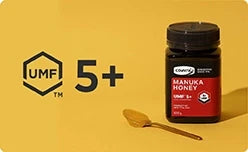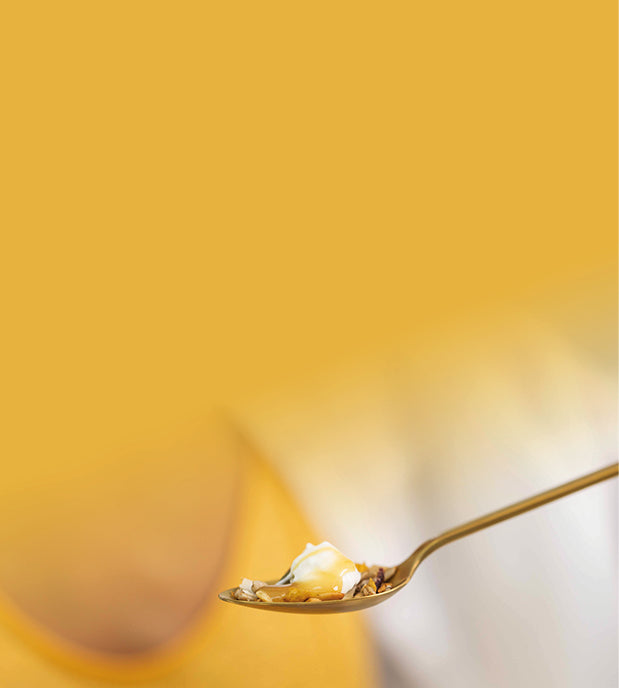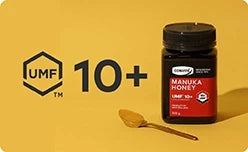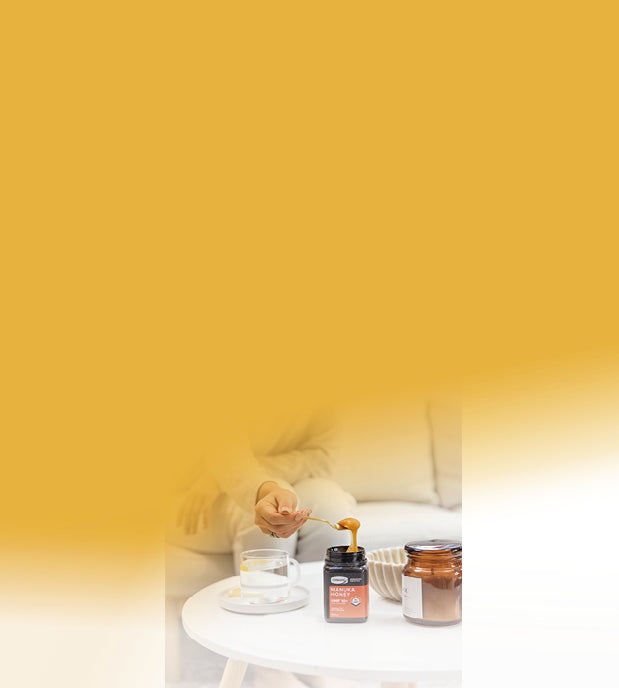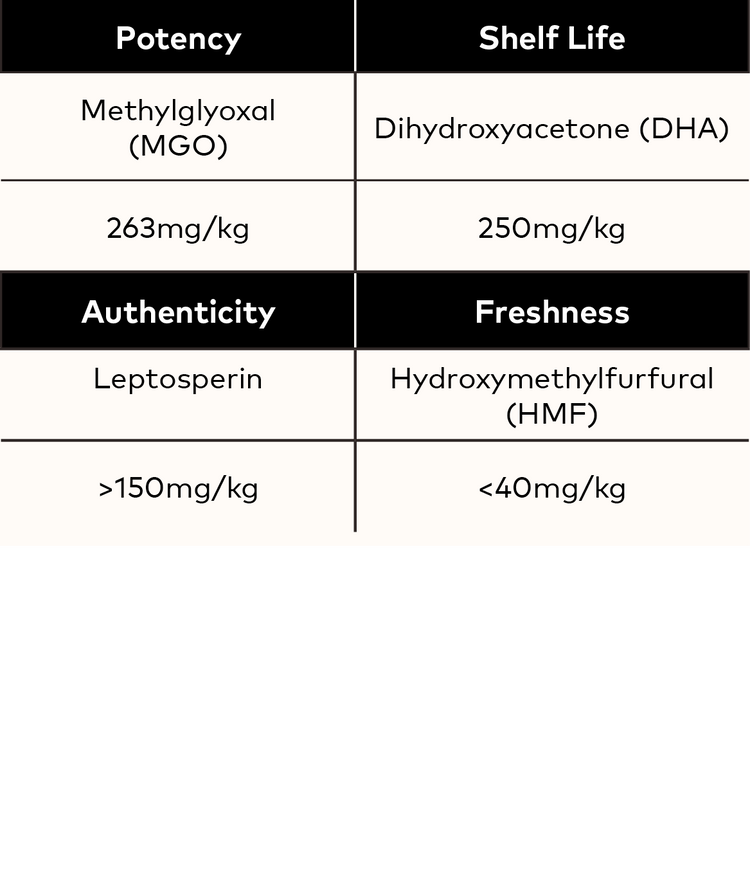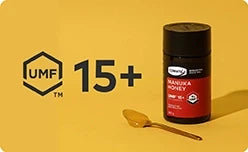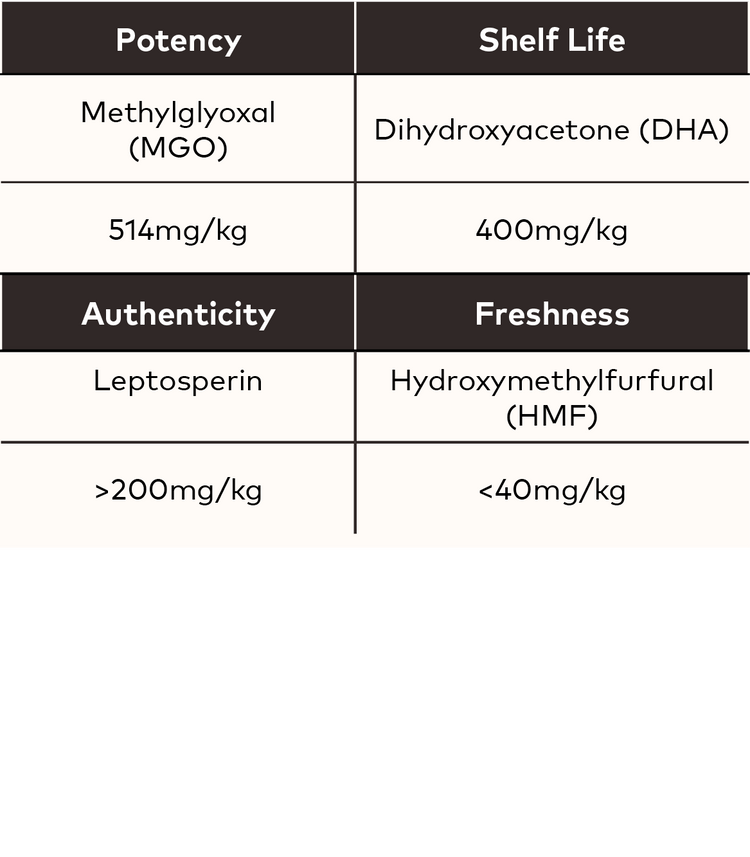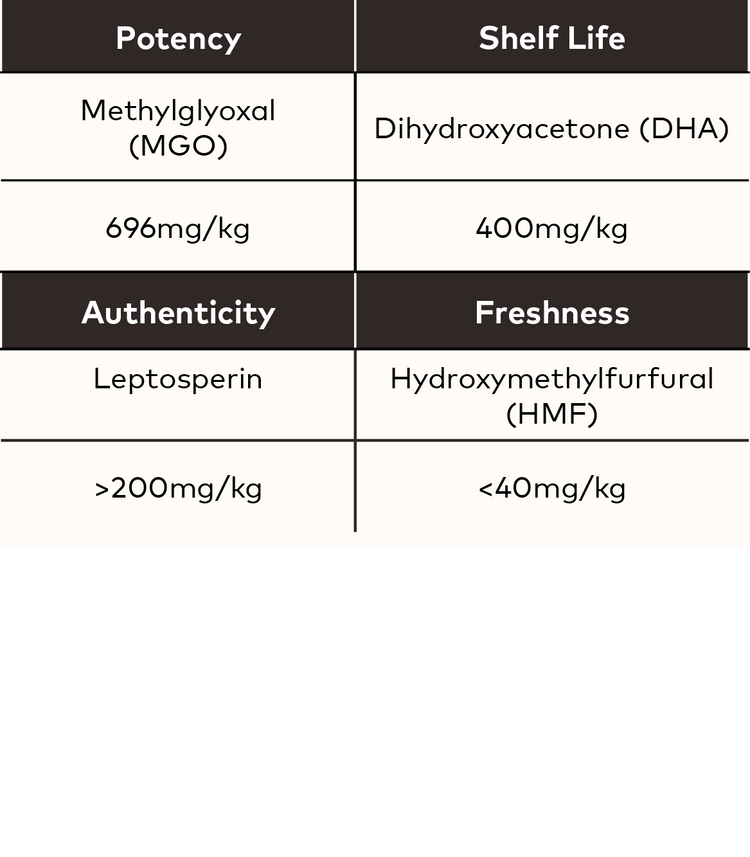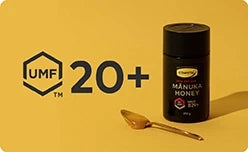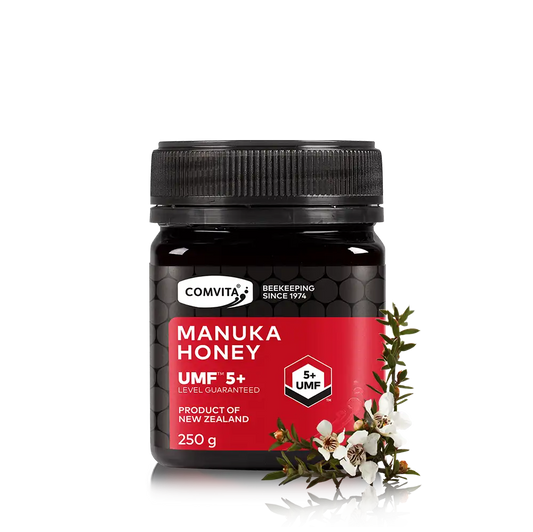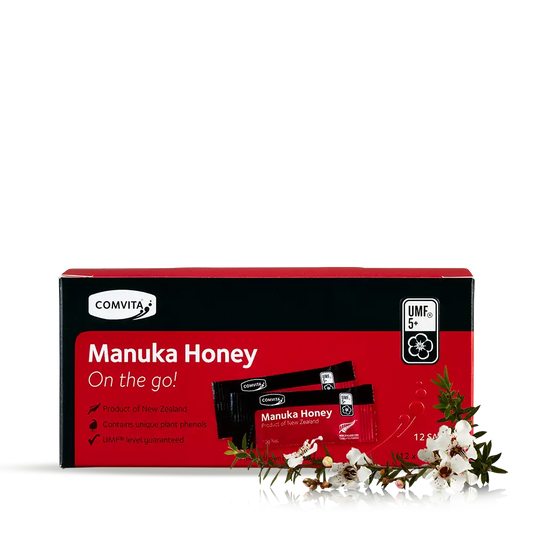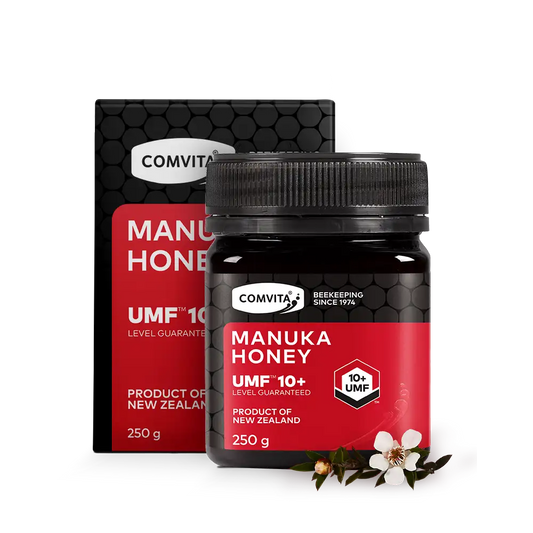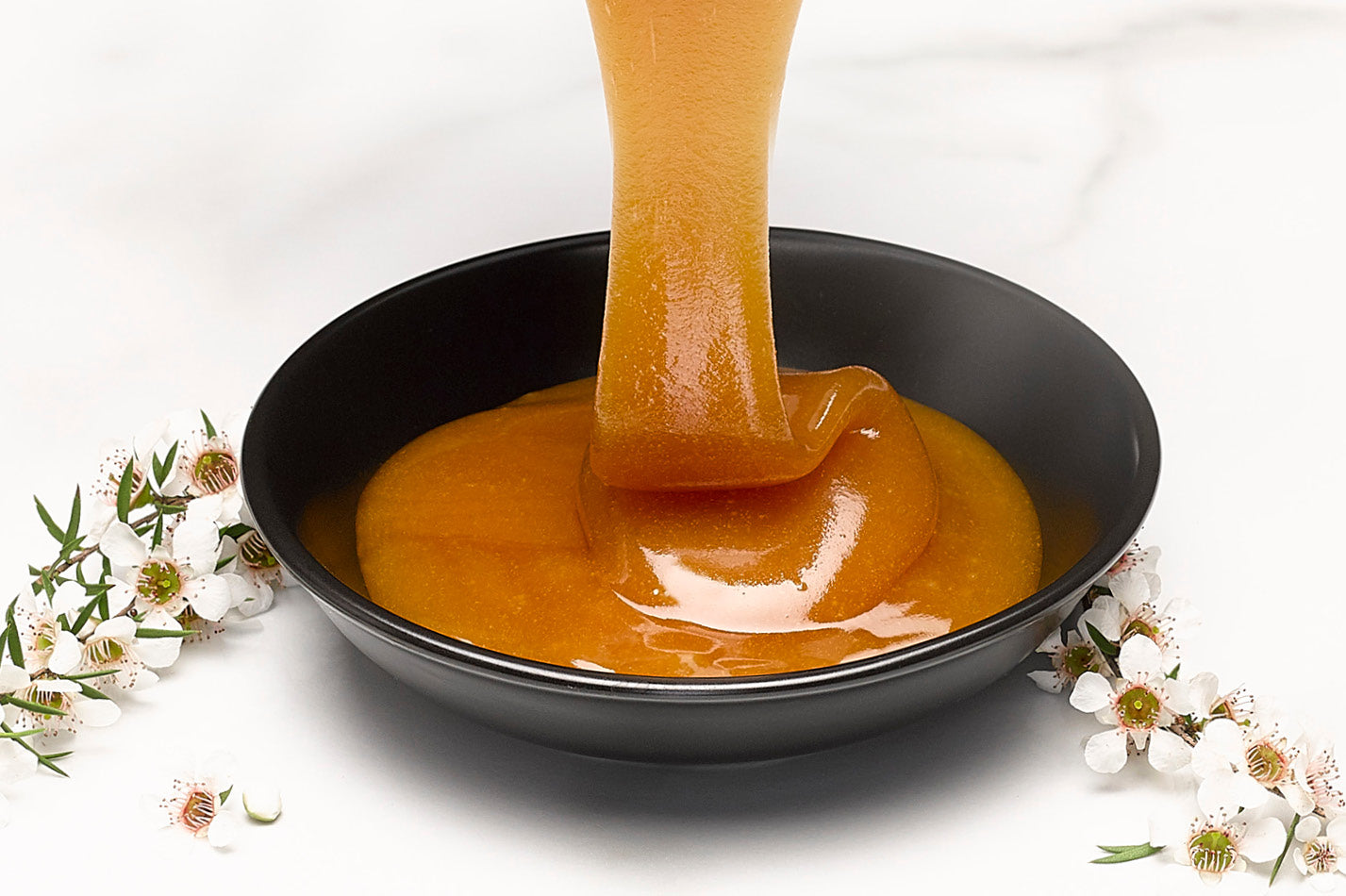
What is Mānuka Honey?
Mānuka honey is a distinctive New Zealand honey recognised for its thick texture, deep amber colour, and flavour that balances sweetness with earthy, slightly bitter notes.
What truly sets it apart is its unique chemical profile, most notably methylglyoxal (MGO), making it one of the most extensively researched honeys in the world, particularly for its distinctive composition and naturally occurring compounds.
In New Zealand, the Ministry for Primary Industries (MPI) sets a strict Scientific Definition for exported Mānuka honey, based on both chemical markers and DNA from Mānuka pollen. This ensures the honey is predominantly sourced from the Mānuka plant and meets recognised authenticity standards.
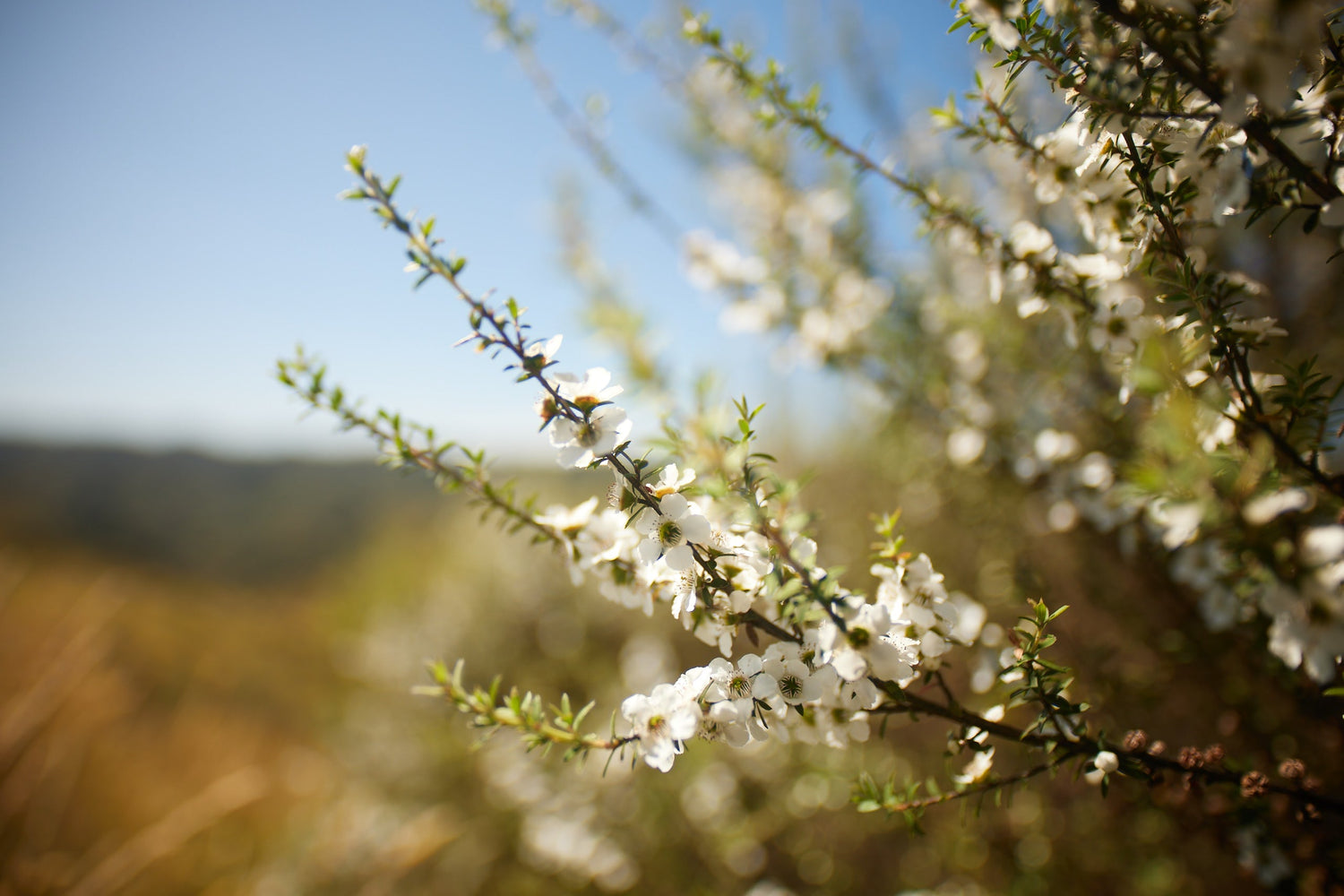
Where does Mānuka Honey come from?
Genuine Mānuka honey comes exclusively from New Zealand, where the Mānuka bush (Leptospermum scoparium) grows in its natural, often remote habitats. These landscapes range from coastal plateaus to rugged mountain valleys. At Comvita, many hives are placed in untouched environments, sometimes accessible only by helicopter or hiking. This careful sourcing helps ensure the authenticity of every jar.

How is Mānuka Honey made?
The making of Mānuka honey begins in the hive. Bees collect nectar from Mānuka flowers, then transform it by reducing the water content from about 80% to 20% through constant fanning of their wings. They seal it with beeswax, preserving the honey naturally. Beekeepers step in only to guide hive placement, protect the colonies, and collect the honey.
Want to learn more about our hives? Read about our heroes - bees!

Why do people value Mānuka Honey?
Beyond its distinctive taste, Mānuka honey is valued for its naturally occurring compounds which are present at levels not typically found in regular honey. People enjoy it straight from the spoon, in warm drinks, or in recipes, and some also use it in natural skincare.

What is MGO?
MGO stands for methylglyoxal, a naturally occurring compound found at uniquely high levels in Mānuka honey. The higher the MGO rating, the greater the concentration of this compound. Because it is stable over time, MGO is recognised as a key indicator of the honey’s unique profile. However, MGO alone is not enough to confirm authenticity, which is why the UMF™ system also measures other compounds.

What is UMF™ (Unique Mānuka Factor)?
UMF™ is an independent quality trademark that verifies the authenticity, purity, and strength of New Zealand Mānuka honey. It measures four key compounds: MGO, DHA, Leptosperin, and HMF, confirming potency, floral origin and shelf life. Every UMF™ product undergoes 34 quality checks and is independently tested and certified in New Zealand.
Learn more in our guide: What is UMF™ Mānuka Honey?
The four key compounds measured by UMF™
-

Methylglyoxal (MGO)
The benchmark compound used to measure potency.
-

Dihydroxyacetone (DHA)
Found in the Mānuka flower’s nectar; it naturally converts into MGO as honey matures.
-

Leptosperin
A plant-derived marker unique to Mānuka honey, confirming authenticity.
-

Hydroxymethylfurfural (HMF)
An indicator of freshness; low levels show careful harvesting and storage.

Are MGO and UMF™ the same thing?
Not quite. An MGO rating measures only the concentration of one compound. UMF™, on the other hand, verifies four compounds while also confirming authenticity, purity, and freshness. Choosing UMF™-certified honey provides greater assurance of both strength and origin.
For a comparison see What is the difference between UMF™ & MGO?

How does Mānuka Honey taste?
Mānuka honey has a dense, velvety texture and ranges in colour from dark cream to deep amber. Its flavour balances natural sweetness with earthy, herbal, and slightly bitter notes. Higher UMF™ grades have a more intense, savoury taste, reflecting the concentration of compounds.

Why does Mānuka Honey cost more than regular honey?
As the Mānuka flower blooms for only a few weeks each year, bees have a short window of time to collect nectar. Many hives are located in remote areas, making placement, monitoring, and harvest complex.
Every batch also undergoes rigorous testing and certification. Factors such as rarity, challenging logistics, and strict quality control explain why genuine Mānuka honey commands a higher price.
-
Our story
Discover our full storyFounded in 1974 by Claude Stratford and Alan Bougen, Comvita began with a handful of hives and a shared vision to help people live well through nature. Today, we are a global wellness company rooted in Mānuka honey and bee products.
-
Our research
Learn more about our researchWith over five decades of experience, Comvita continues to lead in Mānuka honey science. Each batch undergoes 34 quality checks, and our research spans from clinical studies on gut health to exploring Comvita Lepteridine®.
-
Our certifications
Read about our testing and certification.Comvita is a licensed member of the UMF™ Honey Association. Our honey is independently tested in accredited laboratories and produced under strict HACCP standards. Comvita is also a Certified B Corporation™.

Where and how is Comvita's Mānuka Honey tested?
To be legally labelled as ‘Mānuka honey,’ it must meet the Ministry for Primary Industries (MPI) definition, confirmed by chemical fingerprinting and pollen DNA analysis. Comvita goes further, testing for signature compounds like MGO, DHA, and Leptosperin, as well as Comvita Lepteridine®, a proprietary marker used in our research. These controls verify authenticity and quality.

How do I know if Comvita's Mānuka Honey is genuine?
Every jar carries the UMF™ mark, guaranteeing independent testing and certification. Each batch is fully traceable through our tracking system. Simply scan the code on your jar to see its harvest origin and test results. In addition to the UMF™ trademark, Comvita’s Mānuka honey meets MPI’s Scientific Definition for export, which verifies authenticity through advanced testing of natural compounds and pollen DNA.

Is Comvita's Mānuka Honey organic?
While our Mānuka honey is not certified organic, it is naturally non-GMO and minimally processed to retain its natural compounds. Handled with care from hive to jar, each batch is tested and traceable.

Does your Mānuka Honey contain antibiotics, hormones, or additives?
No. Comvita’s Mānuka honey is 100% natural and free from antibiotics, hormones, preservatives, or additives. What you taste is exactly what the bees create, harvested and bottled in New Zealand.

What about common herbicides like Glyphosate?
Comvita Mānuka honey is independently certified Glyphosate Residue Free by The Detox Project, with testing down to government-recognised limits of detection. This certification provides an additional layer of quality assurance.
Learn how Comvita tests for Glyphosate Residue Free certification.

What’s the difference between Australian and New Zealand Mānuka Honey?
New Zealand has a single native Mānuka species (Leptospermum scoparium). Australia has over 80 related species, which produce a variety of honeys. New Zealand’s UMF™ system also provides independent verification not used in Australia, making New Zealand the recognised source of genuine Mānuka honey.

DAILY: Vitality & wellness
- UMF™ 5+ is our most versatile grade of Mānuka honey.
- Rich in natural compounds, with a smooth flavour, it’s easy to incorporate Mānuka goodness into your nutritious daily menu.
- It’s a great snack, or sugar replacement that has the benefits of Mānuka.

UMF™ Level Guaranteed in every spoonful, to the bottom of the jar.

DAILY: Nourishing wellness
- UMF™ 10+ is one of our best-selling grades of Mānuka honey.
- Recommended grade for people seeking to maintain balance; consumed straight off the spoon, or as a tonic when mixed with warm water.
- It also makes a great pre work-out energy boost.

UMF™ Level Guaranteed in every spoonful, to the bottom of the jar.

DAILY: Holistic health inside and out
- UMF™ 15+ is recommended for people seeking the antibacterial, anti-inflammatory benefits of high UMF™ Mānuka honey.
- Consume straight off the spoon
- Soothing when applied to the skin for treating certain conditions.

UMF™ Level Guaranteed in every spoonful, to the bottom of the jar.

TARGETED: Strong and potent
- UMF™ 18+ is recommended for people seeking to step up their everyday wellness regime and wanting an increased level of antibacterial activity provided through higher MGO levels.
- Most effective when consumed straight off the spoon.

UMF™ Level Guaranteed in every spoonful, to the bottom of the jar.

TARGETED: Pure, potent and powerful
- UMF™ 20+ is recommended for people seeking the benefits of very high strength Mānuka honey.
- To support and boost digestive wellness when you simply need the best.
- Most effective when consumed straight off the spoon.

UMF™ Level Guaranteed in every spoonful, to the bottom of the jar.
-
Mānuka Honey & Blueberry Muffins
Get the full recipeSoft, moist, and bursting with blueberries, these muffins are enriched with the distinctive flavour of Mānuka honey.
-
Overnight Oats: Mānuka Honey & Dates
Get the full recipeCreamy oats soaked overnight in yoghurt, sweetened with Mānuka honey and the caramel richness of dates for an effortless, nourishing breakfast.
-
Mānuka Honey Chantilly Cream
Get the full recipeA light, whipped cream sweetened with Mānuka honey. Try different UMF™ levels for subtle flavour variations. Ideal with cakes, scones, or pikelets.
-
Mānuka Honey Roasted Pears
Get the full recipePears roasted to perfection, infused with the caramelised sweetness of Mānuka honey. Elegant enough for dessert, yet simple enough for every day.
-
Comvita Is Independently Certified Glyphosate Residue Free
Read the full blogHow independent certification (Glyphosate Residue Free) safeguards purity.
-
Comvita Reports Positive Results from SOOTHE Clinical Trial
Read the full blogHow Lepteridine® Mānuka honey is shaping new research into digestive health.
-
7 Exceptional Benefits of Mānuka Honey
Read the full blogExplore the many ways this rare honey is valued around the world.
-
7 Facts about Mānuka Honey
Read the full blogA closer look at the New Zealand Mānuka bush, its seasonal bloom, and what makes this honey so unique.



















